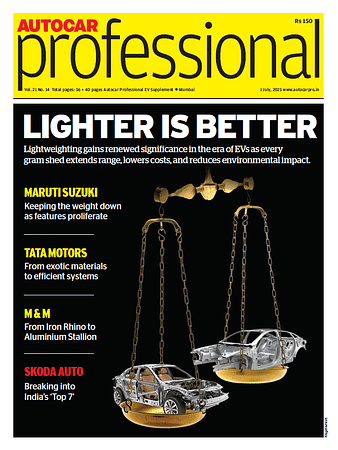CVs in FY25: On The Slow Road To Recovery
The commercial vehicle sector witnessed a mixed performance in FY25, led by buses with a 15% growth, and declines in both Medium & Heavy CV and LCV markets.
India's commercial vehicle sector displayed a mixed performance in FY2025, with buses emerging as the standout segment with a robust 15% year-on-year growth, driven by mandatory scrapping of government vehicles and healthy replacement demand.
However, the truck segments faced headwinds, with M&HCV trucks declining 4% and LCV trucks dropping 3% year-on-year, impacted by election-related disruptions and elevated financing costs. Despite these challenges, market leaders like Tata Motors, Ashok Leyland, and Volvo Eicher reported varied results across their product portfolios, with passenger carriers and exports showing resilience against the broader market slowdown.
Buses led the growth in FY25, driven by scrapping of older government vehicles and replacement demand, while M&HCV numbers fell, partly due to poor demand owing to fewer projects awarded in the wake of general elections. There was some back-ended recovery seen in volume offtake in line with the pick up in the construction and infrastructure activities and steady economic environment.
The LCV (trucks) segment saw a 3% YoY volume de-growth in FY2025, as elevated financing costs and slowdown in the ecommerce segment continued to have a bearing on demand. Increasing preference for pre-owned vehicles over new vehicles amidst increasing total cost of ownership has also been one of the headwinds for the sector in the recent past.
Kinjal Shah, Senior Vice President & Co-Group Head, Corporate Ratings, ICRA highlighted that infrastructure spending has a strong bearing on the performance of the M&HCV (trucks) segment, but it also shows up as demand for LCV (trucks), especially in the rural areas. Projects started gradually getting rolled out in the second half of FY25.
"The rural demand also regained momentum in the post-monsoon months, thus further boosting volume offtake mainly for LCVs," Shah explained, adding that while availability of financing has not been a challenge, the cost of funding remains elevated, which has been a constraining factor, especially for first time buyers. Erratic and irregular monsoons was another headwind which had some bearing on rural demand through the early months of the fiscal.
Sales data sourced from leading OEMs tell the story. For instance Tata Motors, the total CV sales declined by 5% in FY25 to 376,903 units vis-a-vis previous year. The HCV trucks declined by 9%. SCV cargo and pickup dipped by 13%. However, on the other hand, ILMCV grew by 6%, while passenger carriers increased by 17%. Exports too witnessed a 3% jump during the comparable period. Girish Wagh, Executive Director, Tata Motors Ltd. said, “FY25 ended on a positive note for Commercial Vehicles industry, post the YoY demand decline witnessed earlier.”
Ashok Leyland, on other hand had flattish growth overall at 195,097 units sold in FY25, with the domestic business witnessing a 2% decline. Within the subcategories, MHCV trucks declined by 3%, although MHCV buses increased by 19%. LCV wholesales witnessed a 1% increase. A similar story played out at VE Commercial Vehicles. Total Eicher Trucks and Buses (inclusive of EVs) witnessed a 5.6% hike at 87,724 units in FY25 as against FY24. SCV/ LMD Trucks < 18.5T reported a 0.2% drop.
HD (≥18.5T) increased by 2.4%, while LMD Bus grew by 16.4% and HD Bus grew by 11.9%. The domestic business grew by 4%. On the export front, LMD witnessed 48.6% growth, followed by HD and buses which grew by 21.2% and 27.2% respectively. The exports overall grew by 39.2%. On the other hand, total Volvo Trucks & Buses wholesales declined by 1.4% to 2,437 units in FY25.
Society of Indian Automobile Manufacturers (SIAM) said fleets are migrating towards higher GVW vehicles, with the expanding highways and expressway network auguring well for the segment. It noted that road construction and a focus on mass-mobility boosted bus sales.
Way Forward
India's domestic CV industry is expected to register a 3-5% YoY growth in wholesale volumes in FY2026, following a couple of years of flattish volumes. Growth is expected to be driven by an improving economic environment, coupled with resumption of construction and infrastructure activities after the general elections, and replacement demand due to ageing fleets and government mandates.
While the M&HCV (trucks) and LCV (trucks) segments are likely to see a modest, lower single digit YoY volume growth for the fiscal, the buses segment is likely to register a moderate, higher single-digit volume growth for the fiscal, according to ICRA. "A few of the key trends to watch in the domestic CV space would be the extent of electrification across the sub-segments, and purchases of new vehicles against furnishing a scrappage certification," said ICRA’s Shah.
Girish Wagh anticipates sustained growth boosted by higher fleet utilization, financial support from rate cuts, lower crude oil prices, and a renewed focus on large-scale infrastructure projects. "At the same time, we remain mindful of the potential impact of new regulations mandating truck cabin air conditioning on vehicle prices," he added.
RELATED ARTICLES
Auto Giants Explore Hybrid Strategy as EVs Hit Speed Bumps
Slower-than-expected EV adoption, tight CAFE norms and ever-present efficiency demands are giving hybrids a second wind ...
Continental Taps India as Global Hub for R&D and Manufacturing
Continental’s spin-off of its automotive business into AUMOVIO marks a strategic shift, placing India’s engineering and ...
India's EV Story: Promise, Progress, and Challenges
Amid the fanfare of new launches and soaring expectations, mainstream buyers remain hesitant.





 By Shahkar Abidi
By Shahkar Abidi
 03 May 2025
03 May 2025
 5061 Views
5061 Views





 Ketan Thakkar
Ketan Thakkar




